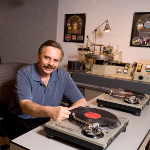Vinyl Mastering Outlook: Can Lathes Keep up the Pace in 2013?
Last month, the music industry got some decent news from the Nielsen SoundScan 2012 report.
In a year where Adele reigned again with 4.4 million copies of 21 sold in the US (10 million plus total), other sectors posted gains as well. Full album downloads were up 14 percent, achieving a new high of 118 million, while digital downloads increased by 5 percent to reach 1.3 billion. Solid smashes like Gotye’s “Somebody That I Used to Know” (6.8 million downloads), Carly Rae Jepsen’s “Call Me Maybe” (6.5 million) and fun.’s “We Are Young” (almost 6 million) set the pace on iTunes and Amazon.
One sector that outpaced all of the above was the growth of vinyl albums: the sales rise of 18 percent to 4.6 million set a new SoundScan record. And those millions are actually spread out among a wide number of releases – consider that Jack White’s “Blunderbuss” was #1 with 34,000 copies, besting the Beatles’ “Abbey Road” at #2.
Mastering engineers who know how to cut vinyl are one group that benefits directly from this trend. Craftsmen who were trained in the highly exclusive art of mastering, these engineers have a unique opportunity in this expanding market. But they could have told you that 2012 was going to be a bumper crop months ago, based on the increased activity they experienced throughout the year.
“I’ve seen a steady and dramatic increase in interest in vinyl for the past few years,” confirms Scott Hull, Owner of Masterdisk on NYC’s West Side. “And the increase grew this past year, in both number of new clients and gross billing. Two additional engineers on my staff have trained and apprenticed as cutting engineers this year — one of which is likely the youngest vinyl cutting engineer actively cutting. In dollars, for the year, 2012 showed a 15% increase in revenue attributable to vinyl over 2011.”
Get a quick primer on vinyl record creation here, then be sure to watch Part II.
For Pete Lyman, Co-Owner of Infrasonic Sound in Los Angeles, the trend was similarly positive. “The last 3 years have been steadily rising,” he says. “In 2012 our vinyl mastering more than doubled and it was our busiest year.”
Even more encouraging is the experience of Carl Rowatti of Trutone Mastering, which operates just north of NYC, and sees 2013 off to an even faster start than his already healthy 2012. “As a rough guess I would estimate 20 to 25% [increase in vinyl cutting projects],” he says, “However the increase ramped up as the year progressed, so the later part of the year saw a substantially greater increase. And already January 2013 shipped twice as many lacquers as January 2012.”
Why Vinyl Keeps Rising
Up until a few years ago, dance records dominated the lathes of mastering engineers who cut vinyl. But just as DJ’s have been graced with a growing number of solutions that allow them to make better use of digital files and thereby de-emphasize platters, there has been a crossfade to increased appreciation for vinyl by a rapidly growing number of indie artists and their fans.
“Bands often tell me that one of the greatest feelings as a recording artist is when they hold a vinyl record of their recording in hand,” notes Joe Lambert, founder of Joe Lambert Mastering in Brooklyn’s DUMBO district. “It represents something to us. It’s something you can’t do in your bedroom. It’s big, physical, it reminds us of the records we loved and grew up admiring. Bands and labels also realized that fans at shows became less interested in buying their CD but were interested in buying the vinyl: If you have a band that will be touring they can sell a lot of records on the road, so labels are willing to invest in the product.”
“Vinyl is the last viable physical format,” agrees Lyman, whose mastering credits include Matt & Kim, Black Rebel Motorycle Club, J Rocc, Maroon 5, PJ Harvey, and Imperial Teen. “It gives listeners an experience that you can’t get from a digital download. You get nice artwork, liner notes, and a great-sounding playback format. I like to compare it to the difference between watching a reality TV show and a fine film: Vinyl delivers the music the way the artist intended.”
As Paul Gold of Brooklyn’s Salt Mastering notes, that attitude can often come from the top down as well, originating from the label side – which often have more ample funds to budget for a vinyl pressing. “Serious music lovers listen to vinyl,” he points out. “Vinyl gets into the right hands. Certain genres are vinyl-centric. Many of the labels I work for release vinyl for almost every release. It is important to them.”
In addition, with the vast reduction of physical product retailers in the US, stocking vinyl records – along with their steadily-declining-in-sales CD’s — has emerged as a necessity for the few chains and mom & pop stores that remain. Equally important is the aural experience that consumers have when they take the shrink wrap off their purchase, drop the needle, and begin to listen.
“As a pro-audio guy I have to believe that the sound of the product has drawn people to the format,” says Hull, who has mastered for the likes of Sting, Dave Matthews, Bob Dylan, Wynton Marsalis, Garbage, Panic at the Disco, Herbie Hancock, The Indigo Girls and Bruce Springsteen. “I’m finding it interesting that compared to lo-bit rate MP3 downloads, vinyl is Hi-Fidelity — that’s pretty funny considering what was said about CD when it replaced vinyl. But with several generations of music fans being very used to low bit-rate digital, they are often surprised by what a pro-quality vinyl sounds like.”
Gains Across Genres
Mastering engineers with vinyl-cutting expertise are seeing business gains from across the musical spectrum. The consensus was the same from facility to facility: the once-mighty dance is down, and almost everything else is on the increase.
“Vinyl sales are up across the board with all genres,” says Infrasonic’s Pete Lyman. “For a long time we had indie and hip hop clients doing vinyl even when no one else was. Now almost every major label LP is coming out on vinyl again.”
Pete Lyman just appeared on Pensado’s Place to talk vinyl and much more.
“I have to say that everyone – across the board is interested in making vinyl,” Hull observes. “From metal to avant-garde, classical to pop/rock, indie and funk and jazz…The genre doesn’t really matter. Most bands want to make a record and many of them find a way to sell enough of them to come back and do it again.”
At Sterling Sound, Senior Mastering Engineer Ryan Smith has seen his own suite get particularly busy with audiophile re-issue projects, which cater to vinyl enthusiasts by commissioning new pressings of classic recordings. “In these cases, attention to sonic detail is the focus with the hope of presenting the record in the best light possible, says Smith. “For me, I’m doing more audiophile re-issue work than new records. A lot of that has to do with my particular studio setup that includes an all-analog signal path for cutting vinyl directly from original master tapes — some of which are over 50 years old. This type of setup is fairly rare these days and really appeals to the audiophile crowd who want the shortest route from the artist’s master tape to the product they purchase.”
Working at High Speed
But this significant uptick in vinyl mastering orders comes with a major caveat. Since most of today’s mastering facilities have only one lathe, and typically a very limited number of qualified personnel with sufficient experience to operate them, taking on the suddenly increased volume represents a challenge.
For Joe Lambert and his staff, the key to keeping up boils down to logistics. “A few months ago we picked up a new client that is sending us a chunk of cutting every month,” says Lambert, whose portfolio includes Moby, Ursala 1000, Fanfarlo, School of Seven Bells, Dirty Projectors & Bjork, Pet Shop Boys, Joe Satriani, and Johnny Cash. “It took a little scheduling acrobatics to get it all worked out to meet their time frame and still get the regular schedule taken care of. My nights have gotten longer this year for sure!”
“Cutting vinyl is not easy — it requires a lot of attention to detail to get it right,” says Sterling Sound’s Smith, who has mastered for such artists as AC/DC, Beyoncé, Nada Surf, Kim Deal, and Rufus Wainwright. “And it can be quite time consuming. But when you have a well cut lacquer in hand at the end of the day, you really feel like you’ve created something! So though it’s difficult and sometimes slow, it’s very rewarding.
“You start to work more efficiently at it when you’re doing it more often. In the past it was more difficult to maintain your feel for cutting since we were doing it less often. It’s such a different process from mastering for digital formats that it would really take time to re-acclimate your head to vinyl when the occasional project came around. Since we’ve been doing a greater volume, it’s easier to jump right into it with the right mindset. This helps free me up creatively — less time thinking about the mechanics of the lathe and more time focused on the music.”
Paul Gold’s approach, at least for the time being, has been to intentionally cap what’s coming in. “I find it challenging to keep up,” concedes Gold, whose discography lists the likes of Sufjan Stevens, Grizzly Bear, Animal Collective, LCD Soundsystem, Eels, and Fucked Up. “Overall I was down 5% this year, and that was by choice. I think everyone involved in vinyl production has plenty of work. I’ve basically been working at capacity for quite a while. If I wanted to limit myself to only cutting lacquers I could. I like mastering so I keep that up — I cut pretty much every day though.”
Facilities with particularly long experience in the art of cutting vinyl, however, have a different perspective on dealing with the increased demand. “There are two reasons keeping up with the workflow has not been an issue,” comments Rowatti, who has mastered for The Rolling Stones, Bruce Springsteen, Bob Dylan, Yung Joc, Cassie, Whitney Houston, Pavarotti, and The Killers. “First, Trutone Mastering Labs was designed as a lacquer cutting facility, not a modified digital mastering suite that can cut lacquers. While the Neumann console we use has been modified to allow for digital mastering and improved sonic performance, it is first and foremost designed to cut lacquer masters and keep the workflow moving.
“Secondly,” he continues. “I have been cutting vinyl for 40 years. When I started my career, and for many years into it, vinyl was the format of choice. Lacquers had to be cut quickly and competently to keep up with a much heavier demand than we have today, so for me the increase is not an issue.”
“Masterdisk was cutting records when the workload was 600 times what it is now,” Hull adds. “All of our senior staff cuts vinyl and half of my younger engineers do also. We have no trouble keeping up with the current volume of work.”
At Lyman’s Infrasonic, where two cutting systems are constantly cranking – with particularly heavy activity before SXSW and Record Store Day– the upside of the hectic pace is the opportunity to hone his staff’s approach to the craft. “More work means more experience,” he points out. “Cutting records in the digital age can be challenging. We’re taking program material that, in most cases, was not meant to be cut to disc. That means we have to develop new techniques to make sure the vinyl mastering translates properly.”
There are significant barriers to entry for becoming a mastering craftsman. An in-shape Neumann lathe can easily fetch $30,000, for example, and it will require knowledgeable maintenance once the new owner stakes possession of it — the last Scully and Neumann lathes were produced in the late 1970’s-early ’80’s. And of course, an intensive apprenticeship and total commitment is required to learn how to successfully operate it. Still as Scott Hull notes, there are reasons beyond commerce for mastering engineers to add it to their repertoire.
“I’ve always felt that becoming a craftsman in record cutting is a vital step to becoming a great mastering engineer in general,” states Hull. “The process, the limitations of vinyl and the experience all test your skills and resources. It used to be that you could not be a mastering engineer without that skill set. It’s tremendous to see that all of that storied experience can be put to the test and help turn more and more people onto vinyl records. Sure it’s old school! So is wine making and hand made glass and pottery.”
It’s worth noting that if demand continues to increase – or even stay level – then a new generation of lathe-capable mastering engineers will need to arise, if the world expect to keep on enjoying vinyl. So even though the current club of vinyl mastering engineers has a lock on the boom, there’s an acknowledgement that fresh talent must emerge.
“There is a bit of a learning curve for people doing vinyl for the first time,” Lambert says, “and understanding the physical limitations and new set of choices to make sure what works best for the project on this particular format. Artists have started making project length and sequence decisions with the vinyl format in mind, which is very helpful to the end result.”
What’s Next for Vinyl in 2013
As a vital part of the supply chain, it’s essential for vinyl-cutting mastering engineers to correctly measure demand in 2013. Sales of digital singles and albums can be expected to keep rising, but will vinyl continue its impressive annual double-digit growth – and if so, can the existing infrastructure keep pace yet again?
“Nothing leads us to believe that we have hit a ceiling yet,” Masterdisk’s Scott Hull says. “More and more old lathes are coming back on line – with mixed results. It turns out that these beasts can be really hard to keep operating at ther peak. It can be pretty expensive maintenance wise. The consumers should be aware though that, like anything else out there, you can get vinyl cut at a very cheap rate, but often with very poor results.”
Rowatti agrees that the gold rush comes with a note of caution. “The number of releases may increase but the problem is that there is only so much manufacturing capacity available and turn times are rather lengthy at most pressing facilities. Unfortunately, years ago when CD was introduced and vinyl rapidly lost popularity, many presses were discarded. I have not heard of anyone building new ones.”
The Emotional Connection
The most encouraging indicator for mastering on vinyl doesn’t come from breaking trends in digital, so much as humans’ long-established love of holding actual artwork in our digits.
“As a consumer-based culture we like to have tangible things,” Joe Lambert says. “We like to own things, and buying a file online may not be satisfying our need the way we’re used to. You can now pay a monthly fee of around $12 to have practically the whole history of recorded music at your fingertips, but people are slow to warm to this. It costs more per month to buy one album of songs you haven’t heard and may not like, but we still seem to prefer this idea.”
In an ever-competitive music industry, vinyl has come full circle — from falling out of fashion to providing a safe bet for raising revenue. In a win-win, the format’s renewed availability is giving music lovers another way to connect with the sounds that they care deeply about.
“Special product draws the fans attention — limited editions, serialized collector copies and the fact that vinyl is at least as cool as a T-shirt at the merch table,” says Scott Hull. “I can be a little naïve sitting in my mastering room, however I don’t know anyone that hires a mover to move a huge CD collection — they just copy the files to a computer. But the vinyl collection is coveted.”
— David Weiss
Please note: When you buy products through links on this page, we may earn an affiliate commission.













Larry R. Schwartz III
February 19, 2013 at 10:17 am (11 years ago)Great article David. The posted video for Pete Lyman gave huge insight to some vinyl “unknowns” and answered a great many questions I have carried with me about the mastering process. Thanks!
Dominic L. Montgomery
April 21, 2013 at 11:27 pm (11 years ago)The insight was really helpful! I love it! Thanks for sharing such wonderful and interesting post. I am a huge fan! Thanks! http://www.distrophonix.com/